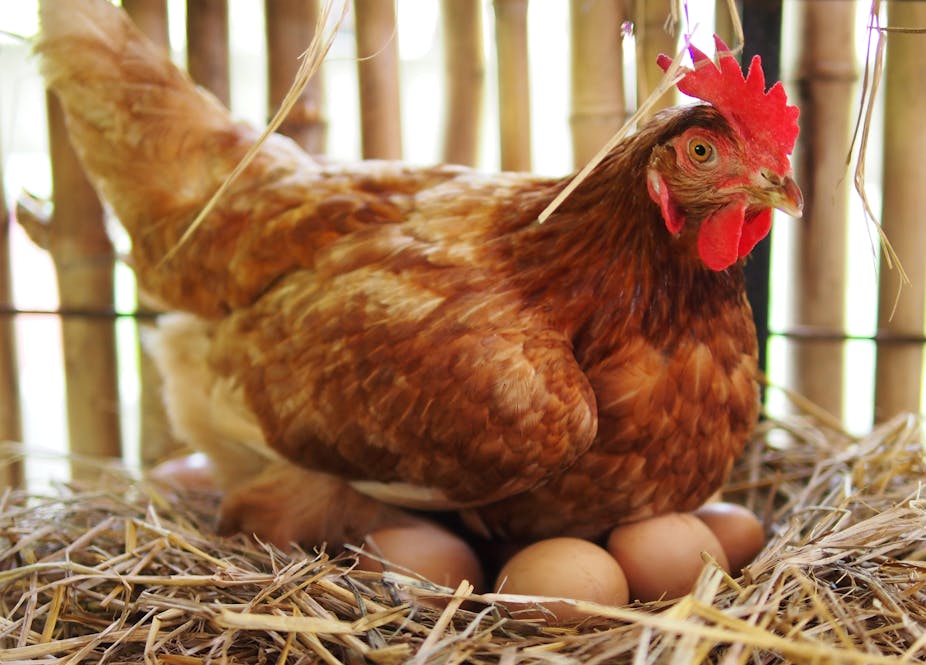This is an article from Curious Kids, a series for children of all ages. The Conversation is asking young people to send in questions they’d like an expert to answer. All questions are welcome: find out how to enter at the bottom.
Why do hens still lay eggs when they don’t have a mate? – Finley, age ten; Evie, age eight; and Jonah, age five, Cambridgeshire, UK
Thanks for the question Finley, Evie and Jonah. Humans have been looking after chickens for thousands of years – and we have gradually learned what to do to make sure our hens keep laying eggs for us to eat.
For one thing, we have gradually changed hens through breeding, to make sure that they don’t stop laying eggs in the winter (hens used to do this naturally).
We’ve also learned that if we keep taking the eggs away from the hens, they will keep laying them, because of the way their bodies work. But for you to really understand why, I’ll have to explain a bit of biology.
In our world, creatures have many different ways of trying to have babies. But one thing is almost always the same: a special cell from a female (called the egg cell) and a special cell from the male (called a sperm cell) have to join together to make the baby.
Each of these special cells contains half of the instructions to make a new creature (the baby).
Usually, the male makes lots and lots of his special cells, all with tails to help them move. He sends lots of them into the female, in the hope that one will swim all the way to the female egg cell and join with it: this is called “fertilising the egg”.
The female makes very few of her special cells and gives them the size and covering they need to let a male sperm cell join with them to make one fertilised cell. Then, the fertilised egg can use the full set of instructions – half from the egg cell and half from the sperm cell – to start growing into a baby.
In animals like humans, the baby grows a lot inside the female before it is born. But in birds like chickens, the egg cell is put into a huge package to feed and protect fertilised eggs while they grown into a baby. We call the whole package “the egg”.
It takes about a day to wrap all the packaging around the egg cell. Most of the layers around the egg cell are soft, but the final wrapper is the hard shell. The shell takes the longest time to make (about 19 hours). The chicken has a clever way of “lending” hard material (calcium carbonate) from her bones to make the shell. She then has to replace the calcium carbonate in her bones by eating more at the next meal.

The female has to be very careful about when she uses her precious eggs cells to try and make a baby. Lots of animals take one egg each month out of the store they have inside their body. Once its out of the store, the egg goes to a part of their body where a sperm could join up with it to fertilise it.
Other creatures, including many kinds of birds, choose a time to release several of their eggs to try and make a group of babies all at once (often called a “litter” for animals and a “clutch” for birds).
The size of a clutch is different for different kinds of bird: for chickens, it is around 12 eggs. In nature, when the female chicken has laid about 12 eggs, she stops releasing egg cells from her body stores. But if humans keep taking the eggs away, the female chicken will keep laying more eggs.
When the female releases the egg cell from her body store, she does not know whether a male sperm cell will come and fertilise it or not. But her body still sends them out from the store, just in case there is sperm to fertilise the egg.
In order not to waste eggs, the female of many kinds of creature (ranging from insects, through garden birds to reindeer) stop releasing eggs from their body store for much of the year, to make sure the babies don’t arrive in the winter time when it is difficult to get enough food for them.
As I mentioned before, humans have gradually changed female chickens over many years so that their bodies don’t stop releasing eggs in the winter, but some traditional breeds still do go “off lay”.
Hello, curious kids! Have you got a question you’d like an expert to answer? Ask an adult to send your question to us. You can:
* Email your question to curiouskids@theconversation.com
* Tell us on Twitter by tagging @ConversationUK with the hashtag #curiouskids, or
* Message us on Facebook.

Please tell us your name, age and which town or city you live in. You can send an audio recording of your question too, if you want. Send as many questions as you like! We won’t be able to answer every question, but we will do our best.
More Curious Kids articles, written by academic experts:

